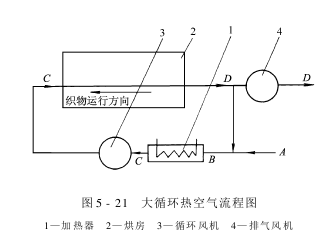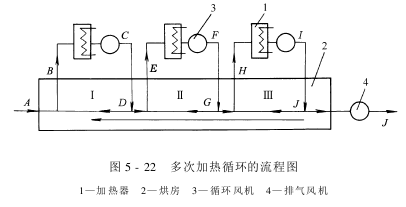Hot air dryer – types and basic working process of hot air dryer
The production efficiency and thermal efficiency of the drum dryer are relatively high, so it is widely used in the printing and dyeing industry. However, the drum dryer uses contact drying, and the temperature difference between the surface of the fabric and the inner layer is large. The contact conditions between the fabric and the surface of the drum are also different, so the drying uniformity is poor.
The main advantage of the hot air dryer is that it uses heated gas to contact the fabric, so the drying effect is relatively uniform and gentle, and the tension on the fabric is small. The hot air dryer can be heated directly by flue gas or indirectly heated by steam or hot oil. It has a higher temperature than the drum dryer that only uses steam heating. Therefore, it can meet the special needs of certain processes such as heat setting and baking. Require. However, the hot air dryer occupies a large area and has low thermal efficiency.
There are many types of hot air dryers. According to the way they transport fabrics, they can be divided into cloth (needle) clip-type hot air dryers, guide roller-type hot air dryers, hanging hot air dryers and ring There are four major categories of dryers; according to their technological uses, they are divided into dryers, heat setting machines, and baking machines; according to heat sources, they are divided into steam, coal gas, flue gas, liquefied petroleum gas, electric heating, and various types of Airborne thermal body, etc.
Hot air drying uses a fan to use forced convection to transfer heat energy to the wet fabric in the drying room and take away the vaporized water vapor on the fabric. Hot air is both a heat carrier and a moisture carrier, so the thermal efficiency of the hot air dryer is low. In order to improve the efficiency of hot air drying, it is necessary to understand the basic process of hot air drying.
In actual production, in order to reduce energy consumption and improve the thermal efficiency of hot air dryers, hot air dryers often adopt the following two methods of heating and recycling hot air.
(1) One-time heating cycle use, that is, the whole machine is used for large-circulation hot air drying. The hot air heating process of this solution is shown in Figure 5-21.

From A After the fresh air is replenished at the point and mixed with part of the reused hot air in the drying room, it is heated to point C by the heater at point B, and is transported to the drying room through the circulating fan 3. After drying the fabric, it is discharged from the drying room to point D. , part is reused, and the other part is discharged by the exhaust fan 4.
When the hot air is used in a large circulation, the temperature of the drying room will not be too high, which is beneficial to reducing heat loss. However, the temperature difference between hot air entering and leaving the drying room is not large, and heating is relatively simple.
(2) Multiple cycle use, that is, the whole machine is cycled and dried in sections.
Figure 5-22 is a flow chart of multiple heating cycles. The fresh air added from point A and the return air from point D in room I are mixed to form point B. It is heated by the heater to point C, and is transported to the drying room by the circulating fan, where it contacts the fabric and changes to state D.
Part of the air returns, and the other part of the air is the supplementary air of room II. It is mixed with the return air G of room II and becomes E state. It is heated by the heater to F state, and is sent to drying room II by the circulating fan, and Fabric contact changes to G state. By analogy, multiple heating cycles can be performed.

Adopt this This solution can not only prevent the temperature in the drying room from being too high, but also make the final exhaust gas have a higher relative humidity, effectively utilizing heat energy. At the same time, the temperature difference between each drying room is small, which is beneficial to improving the uniformity and thermal efficiency of fabric drying. In addition, the temperature, relative humidity and drying rate in each section of the drying room can be controlled separately according to process requirements, so that the drying effect is ideal. At present, hot air dryers widely use this heating cycle method.
AAAKY,7II56U65






